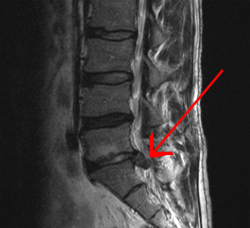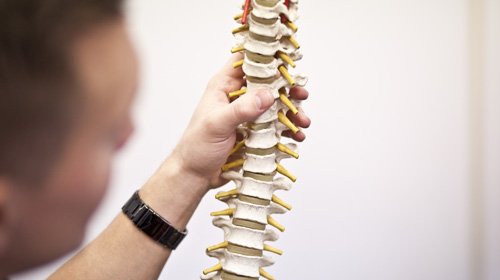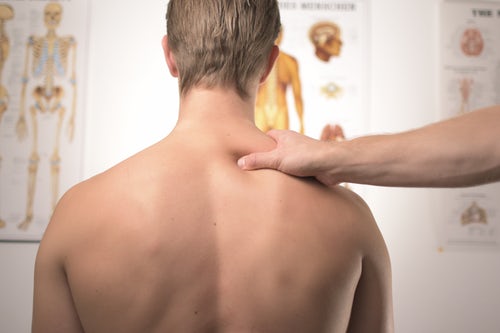|
BOOK NOW |
ASK ABOUT YOUR PAIN |
Home > Blog > Physiotherapy > Spinal Physiotherapy > Herniated Disk Physiotherapy
Herniated Disk Physiotherapy

A herniated disc happens when the cushion-like cartilage (the disc) between the bones of the spine is torn or ruptured, and the gelatin-like core of the disc leaks.
Often mistakenly termed as a slipped disc, a herniated disc can happen due to sudden trauma or by long-term pressure on the spine.
This condition most often affects people aged 30 to 50 years; of this, men are twice as likely to be diagnosed with spinal disc herniation as compared with women. The reason for this may be due to the to risks and causes of it:
- repeated lifting
- participating in weight-bearing sports
- obesity
- smoking
- poor posture are all risk factors for a herniated disc
Good news is that the majority of herniated spinal discs do not require surgery, and respond best to spinal physiotherapy. Our senior physiotherapists design individualized treatment programs to help people with herniated discs
- regain normal movement
- reduce pain
- and get back to their regular activities
What is a Herniated Disk?

Our human spine is made up of 33 vertebrae (bones) stacked on top of each other. Between each vertebra is a cushion-like piece of cartilage called an "intervertebral disc." You can imagine the spinal disc as a jelly donut:
- The outer portion of the disc is a rubbery substance (the "annulus fibrosus")
- A gelatin-like substance fills the "hole" in the donut (the "nucleus pulposus")
In people younger than 30 years of age, the disc is soft, flexible, and absorbs shock extremely well. As we grow older, however, the disc will start to lose some flexibility. If stress is applied to the spine, the outer part of the disc (annulus fibrosus) can tear, and the gelatin-like core (nucleus pulposus) leaks through the tear.
This leaking, or bulging, of the gelatin is called a herniated disc. In more severe cases, the leaked nucleus pulposus can seep outside the spinal column.
Injuries that cause herniation can occur rapidly, or develop slowly over time:
- A sudden injury can occur when an individual lifts something while in a poor or awkward position. This action strains the spine, and causes the outer part of a disc to suddenly give way and tear.
- A slow injury can occur as the result of sitting or standing with poor posture (slumped forward) for hours, weeks, or years, slowly overstretching or tearing the outer part of a disc.
The most common area of the spine to experience a herniated disc is the low back, just below waist level. Herniated discs also commonly occurs in the neck.
How Does a Herniated Disk Feel?
A herniated disc can cause
- pain
- tightness
- numbness
- weakness
- or tingling in the neck, back, arms, or legs
If the bulging or leaking disc pushes on a nearby nerve, pain or muscle weakness may result.
If the bulging or leaking disc does not push on a nerve, there may not be pain or disability at all. That being said, although back pain or neck pain can be caused by a herniated disc, other factors may be involved. We can test for and rule out other possible conditions.
If a herniated disc is severely pressing on a nerve, or is pressing on the spinal cord, corrective spinal surgery may be needed to immediately relieve that pressure. Our senior physiotherapist can help determine whether either of these conditions is occurring, and will work closely with your orthopedic doctor to determine the correct treatment.
Signs and Symptoms
The types and locations of your symptoms depend on the location and direction of the herniated disc, and the amount of pressure on nearby nerves.
A herniated disc may sometimes cause no pain at all. Or, it can cause any of the following symptoms:
- Pain in the neck, back, low back, arms, or legs
- Inability to bend or rotate the neck or back
- Numbness or tingling in the neck, shoulders, arms, hands, hips, legs, or feet
- Weakness in the arms or legs
- Limping when walking
- Increased pain when coughing, sneezing, reaching, or sitting
- Inability to stand up straight; being "stuck" in a position, such as stooped forward or leaning to the side
- Difficulty getting up from a chair
- Inability to remain in 1 position for a long period of time, such as sitting or standing, due to pain
- Pain that is worse in the morning
In patients who are older than 50 years, the gelatin-like core of the disc (nucleus pulpossus) can become dry and less soft, making it less likely to leak, or herniate. This deterioration, however, can lead to other conditions that cause pain, such as degenerative disc disease, and degenerative joint disease.
We will work with other health care professionals to determine your correct diagnosis.
How Is It Diagnosed?
We will conduct a thorough evaluation that includes taking your health history, asking you detailed questions about your injury, such as:
- How and when did the pain start?
- At what time of day is it worse?
- What type of discomfort do you feel, and where do you feel it?
- What can’t you do right now, in your daily life, due to the pain?
We will perform tests on your body to find physical problems, such as:
- Difficulty moving
- Weakness or tightness in the muscles
- Loss of skin sensation in some areas (numbness)
- Loss of reflexes
- Joint stiffness
- Poor posture
- Difficulty walking
If we finds any of the above problems, your spinal physical therapy treatment may begin right away, to help get you on the road to recovery and back to your normal activities.
If more severe problems are found with any of the testing, we may collaborate with a physician or surgeon to obtain special diagnostic testing, such as an MRI. Be assured that we work closely with physicians and other health care providers to ensure that you receive an accurate diagnosis and the treatment and care you need.
how our senior physiotherapists can help you

Conservative care (such as spinal physiotherapy) often produces better results in treating a herniated disc than surgery or pain medications, such as opioids.
We will work with you to design a specific treatment program that will accelerate your back pain and symptoms recovery, including exercises and treatments that you can do at home. Physiotherapy will help you return to your normal lifestyle and activities.
Patients with slipped disc often ask us how long (time and frequency) it takes to heal and the condition varies, but results can be achieved in 2 to 8 weeks or less, when a proper posture, pain-reduction, stretching, and strengthening program is implemented.
During the first 24 to 48 hours following your diagnosis of a herniated disc, we may advise you to:
- Rest the area by avoiding any activity that causes worsening symptoms in the arms or legs.
- Avoid bed rest.
- Stay active around the house, and go on short walks several times per day. Movement will decrease pain and decrease stiffness, and help you feel better.
- Apply cold therapy to the affected area for 15 to 20 minutes every 2 hours.
- Sit in firm chairs. Soft couches and easy chairs may make your problems worse.
- Consult with a spine doctor for further services, such as medications or diagnostic tests.
Some exercises are better for individuals with herniated discs. We will educate you about them. For example:
- Exercising in water (swimming pool) can be a great way to stay physically active when other forms of exercise are painful.
- Exercises that involve lots of twisting and bending may or may not benefit you. We will design an individualized exercise program to meet your specific needs.
- Weight-training exercises, though very important, need to be done with proper form to avoid stress to the back and neck.
Our senior physiotherapist will work with you to:
Reduce pain and other symptoms
We will help you understand how to avoid or modify the activities that caused the injury, so healing can begin. We may use different types of treatments and technologies to control and reduce your pain and symptoms.
Improve posture
If we finds that poor posture has contributed to your herniated disc, we will teach you how to improve your posture so that pressure is reduced in the injured area, and healing can begin and progress as rapidly as possible.
Improve motion
We will choose specific activities and treatments to help restore normal movement in any stiff joints. These might begin with "passive" motions that we do for you to move your spine, and progress to “active” exercises and stretches that you do yourself. You can perform these motions at home and in your workplace to help hasten healing and pain relief.
Improve flexibility
We will determine if any of the involved muscles are tight, start helping you to stretch them, and teach you how to stretch them at home.
Improve strength
If we finds any weak or injured muscles, we will choose, and teach you, the correct exercises to steadily restore your strength and agility. For neck and back disc herniations, “core strengthening” is commonly used to restore the strength and coordination of muscles around your back, hips, abdomen, and pelvis.
Improve endurance
Restoring muscular endurance is important after an injury. We will develop a program of activities to help you regain the endurance you had before the injury, and improve it.
Learn a home program
We will teach you strengthening, stretching, and pain-reduction exercises to perform at home. These exercises will be specific for your needs; if you do them as prescribed by our senior physical therapist, you can accelerate your recovery.
Return to activities
We will discuss your activity levels with you and use them to set your work, sport, and home-life recovery goals. Your treatment program will help you reach your goals in the safest, fastest, and most effective way possible. For spine injuries like a herniated disc, we may teach you proper “body mechanics”—correct ways to perform tasks and lift heavy objects—that will help protect your spine from further injury.
Once your pain is gone, it will be important for you to continue your new posture and movement habits to keep your back healthy and pain free.
Following Spinal Surgery
In rare cases, corrective spinal surgery is necessary to prevent permanent damage to a nerve or the spinal cord. If you have to undergo surgery for your herniated disc, we will work closely with you and your surgeon to help you regain motion and strength more quickly than you could on your own, and help you get back to your normal lifestyle as quickly as possible.